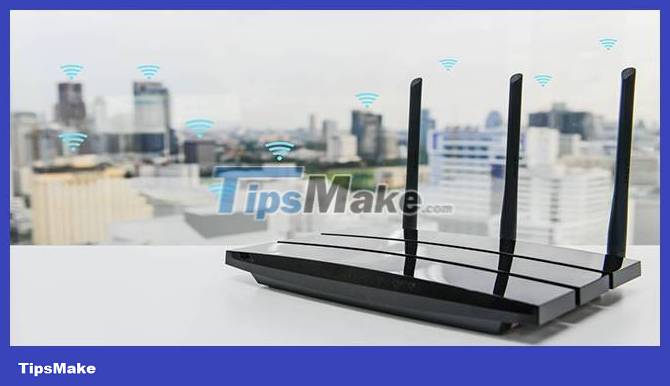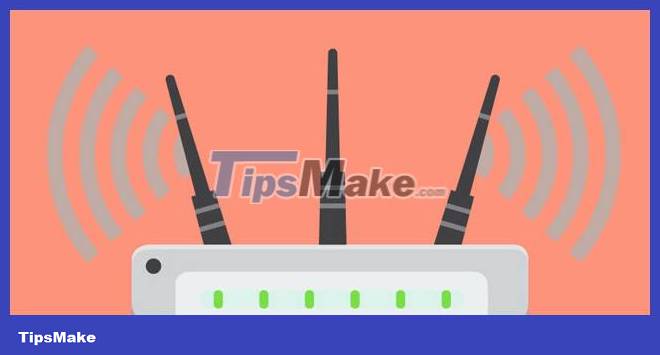Which type of wireless router has the longest range?
Wireless access points, often called wireless routers, provide network access based on radio waves. Although this form of communication does not require cables, there are limitations on how far away the PC needs to be to still be able to communicate with the network device.
Different standards - including 802.11b, 802.11g and 802.11n - of both the wireless adapter and access point will affect the maximum range. However, solving certain problems can improve the range of any wireless router.
Maximum range unobstructed
Currently, routers running the 802.11n standard have the longest range. The unhindered range of this standard, at the same data rate, is nearly double that of the previous 802.11g standard. 802.11g is considered to have an effective range of about 100 to 150 feet (30 - 46m), while 802.11n - the latest adopted standard available - covers a range of about 200 to 300 feet (61 - 46m). 91m). But there are many factors that influence the range from one access point to the next.

Transmission capacity
Many FM stations are used to advertise available capacity. This is because more power to the antenna results in a better ability for the signal to overcome obstacles. Due to imposed limitations, many transmission levels in wireless routers are set by the manufacturer and the ability to adjust them is not available. However, when possible, increasing the transmission power allows the signal to reach further or, more importantly, helps to propagate through materials such as brick or metal walls.
Gain and antenna type
Most routers are installed with omnidirectional antennas. The antennas broadcast with equal signal strength in all directions. This makes a lot of sense when the router is placed in a central location. Special router locations, such as on the far side of a long building, can result in devices on the other half not receiving the signal.
Different types of antennas can take the same transmit power and focus it in different ways. For example, Yagi and other directional antennas focus energy into a single long-range beam commonly used for point-to-point wireless links. . Other antennas radiate energy like an omnidirectional antenna, but focus that energy in a specific direction at a longer range. Such an antenna is ideal for wall mounting.
Interference phenomenon

Wireless routers use unlicensed spectrum. "Unregistered" means anyone can transmit and receive on these frequencies. Excessive transmissions from different sources on the same frequency can lead to signal confusion.
At the very least, this interference reduces usable bandwidth on the wireless network and at worst causes connection drops. These problems occur when too many people are using the same wireless frequency in a geographical area, such as when your next-door neighbor owns a wireless router on the same frequency.
The 802.11 wireless standards allow the use of at least three non-overlapping frequencies. Changing your wireless router frequency to a less 'crowded' option will effectively increase both range and speed. Readers can refer to the article: How to choose the best WiFi channel for your router for more details.
Which long-range wireless router is best?
The power transmitted by all WiFi devices (computers, phones, routers, etc.) is limited by the FCC. Most routers transmit at full allowed power. "Long range" devices may have more efficient antennas. In most cases, these antennas allow the router to hear weaker signals from other devices. That could improve coverage.
Alternatively, routers have long range using directional antennas. Getting more gain in one direction means getting less in the other direction. Most home routers transmit most of their power horizontally in all directions and less vertically.
High-gain antennas are only useful in special situations. However, WAPs for businesses (WAP stands for WiFi Access Point - WiFi Access Point - the radio part of WiFi on the router) are often mounted on the ceiling. A long-range device will transmit more signals downward than toward the ceiling.
In either of the above two cases, improving the antenna will be very expensive. It requires precise manufacturing and careful design. There is a trick used by some 802.11 ac (WiFi 5) routers called Beam Steering. The idea is that if the router knows which direction the device is in, it can modify the phase of the signal for 3 or more antennas to give a little extra benefit in that direction while communicating with that device. This depends on the device also supporting this technology. Generally, when the signal is weak and the speed is low, one can get a little more speed from this technology. however, it does not provide additional range.
Scope is a difficult subject. In a house, range is primarily determined by the number of walls and floors the signal must penetrate, as well as the type of construction material. Stating how much WiFi has a specific range seems meaningless, unless you are in an open field, the path between the router and the device is unobstructed, because the ability to penetrate walls is the main factor. limited range, especially in the 5GHz band.
If you still want to know the operating range of a specific router, you can visit smallnetbuilder.com. This site performs very good range and speed measurements on the reviewed routers.
You should read it
- How to Set Up a Wireless Router
- 'Great' to speed up Wifi to Wireless Router
- How to set a password for Wireless
- Why need to change the wireless channel of the router?
- How to set up WEP, WPA, WPA2 for Linksys router
- 5 tips to help make optimal use of Tomato on the Router
- Top 5 best Xiaomi WiFi routers
- 3 best wireless routers 2021
May be interested
- Top 5 best Xiaomi WiFi routers
 wireless routers are being used in almost every corner of the world today. the best wireless router will ensure your network connections are strong and reliable.
wireless routers are being used in almost every corner of the world today. the best wireless router will ensure your network connections are strong and reliable. - 3 best wireless routers 2021
 whether you want the fastest and most powerful wifi router, feature set that focuses on gaming or wifi speeds just right and won't leave you out of pocket, there's always a wireless router option for you. it is important to know what to look for.
whether you want the fastest and most powerful wifi router, feature set that focuses on gaming or wifi speeds just right and won't leave you out of pocket, there's always a wireless router option for you. it is important to know what to look for. - Create a virtual wireless Router with Windows
 in this tutorial we will show you how to create a virtual wireless router in windows to share internet connection and file sharing.
in this tutorial we will show you how to create a virtual wireless router in windows to share internet connection and file sharing. - Review Tenda N301: The router is compact and affordable
 the tenda n301 router was released in 2013. tenda n301 is equipped with broadcom bcm5357c0 300 mhz chipset, 16mb ram and 2mb flash memory. tenda n301 wifi router is compatible with ieee 802.11b / g / n standards.
the tenda n301 router was released in 2013. tenda n301 is equipped with broadcom bcm5357c0 300 mhz chipset, 16mb ram and 2mb flash memory. tenda n301 wifi router is compatible with ieee 802.11b / g / n standards. - How to Set up a Wireless Network in Windows XP
 this is a walkthrough of setting up wireless (ieee 802.11 also known as wifi) home networking with windows xp. note that if buying a router, all routers are compatible with windows xp. it is wireless adapters that have varying levels of...
this is a walkthrough of setting up wireless (ieee 802.11 also known as wifi) home networking with windows xp. note that if buying a router, all routers are compatible with windows xp. it is wireless adapters that have varying levels of... - Build a wireless network with a broadband router - Part 1: Prepare hardware
 wireless networks can be set up at your home or office, from which you can share files, use printers and access the internet without having to run a jumbled network cable to network computers. .
wireless networks can be set up at your home or office, from which you can share files, use printers and access the internet without having to run a jumbled network cable to network computers. . - How to Connect HP Deskjet 3050 to a Wireless Router
 after connecting your hp deskjet 3050 printer to your wireless router, you can conveniently print documents without worrying about cables. just know the router username and password, you will easily connect your hp deskjet printer to the wireless router on any windows or mac computer.
after connecting your hp deskjet 3050 printer to your wireless router, you can conveniently print documents without worrying about cables. just know the router username and password, you will easily connect your hp deskjet printer to the wireless router on any windows or mac computer. - Build wireless networks with a broadband router - Part 3: Connect wireless computers to the network
 through the previous two parts of this series, all computers that are now directly connected to the router with a regular cable can access the internet. the next step is to allow computers to use the connection
through the previous two parts of this series, all computers that are now directly connected to the router with a regular cable can access the internet. the next step is to allow computers to use the connection - How to Set up a Wireless Network in Linux
 a walkthrough of wireless (ieee 802.11 also known as wifi) home networking with linux. most wireless adapters are not designed for use in linux and depend on non-free proprietary drivers and firmware which inevitably leads to problems....
a walkthrough of wireless (ieee 802.11 also known as wifi) home networking with linux. most wireless adapters are not designed for use in linux and depend on non-free proprietary drivers and firmware which inevitably leads to problems.... - How to upgrade the Wireless Router Firmware?
 upgrade the firmware firmware to a good idea. so how to upgrade the firmware for wireless router? please refer to this article!
upgrade the firmware firmware to a good idea. so how to upgrade the firmware for wireless router? please refer to this article!










 Difference between WiFi and Internet
Difference between WiFi and Internet Is WiFi or mobile data more secure?
Is WiFi or mobile data more secure? Which is faster, WiFi or mobile data?
Which is faster, WiFi or mobile data? How to set up Wifi in the car
How to set up Wifi in the car What is Band Steering?
What is Band Steering? How does the device use WiFi to determine your physical location?
How does the device use WiFi to determine your physical location?